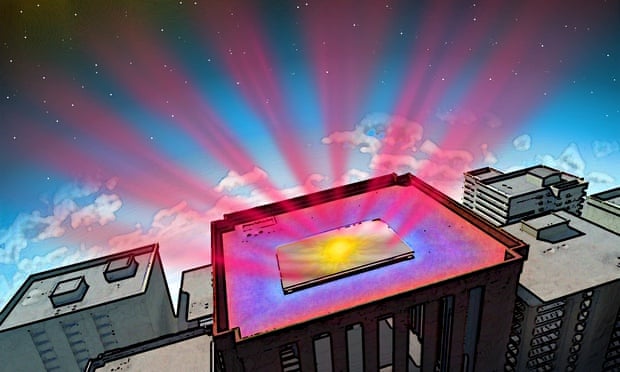 Posted Nov 27, 2014, 7:00 AM
Posted Nov 27, 2014, 7:00 AM
|
 |
Registered User
|
|
Join Date: Aug 2002
Location: Toronto
Posts: 52,200
|
|
|
Mirrors could replace air conditioning by beaming heat into space
Mirrors could replace air conditioning by beaming heat into space
26 November 2014
By Ian Sample
Read More: http://www.theguardian.com/science/2...ing-heat-space
Quote:
A mirror that sends heat into the frigid expanse of space has been designed by scientists to replace air-conditioning units that keep buildings cool on Earth. Researchers believe the mirror could slash the amount of energy used to control air temperatures in business premises and shopping centres by doing away with power-hungry cooling systems.
- Around 15% of the energy used by buildings in the US goes on air conditioning, but the researchers’ calculations suggest that in some cases, the mirror could completely offset the need for extra cooling. --- In a rooftop comparison of the device in Stanford, California, scientists found that while a surface painted black reached 60C more than ambient temperature in sunlight, and bare aluminium reached 40C more, the mirror was up to 5C cooler than the surrounding air temperature.
- “If you cover significant parts of the roof with this mirror, you can see how much power it can save. You can significantly offset the electricity used for air conditioning,” said Shanhui Fan, an expert in photonics at Stanford University who led the development of the mirror. “In some situations the computations say you can completely offset the air conditioning.”
- The Stanford mirror was designed in such a way that it reflects 97% of the visible light that falls on it. But more importantly, it works as a thermal radiator. When the mirror is warmed up, it releases heat at a specific wavelength of infrared light that passes easily through the atmosphere and out into space.
- To make anything cool requires what engineers call a heat sink: somewhere to dump unwanted heat. The heat sink has to be cooler than the object that needs cooling or it will not do its job. For example, a bucket of ice will cool a bottle of wine because it becomes a sink for heat in the liquid. Use a bucket of hot coals and the result will the very different. The Stanford mirror relies on the ultimate heat sink: the universe itself.
- The mirror is built from several layers of wafer-thin materials. The first layer is reflective silver. On top of this are alternating layers of silicon dioxide and hafnium oxide. These layers improve the reflectivity, but also turn the mirror into a thermal radiator. When silicon dioxide heats up, it radiates the heat as infrared light at a wavelength of around 10 micrometres.
- Since there is very little in the atmosphere that absorbs at that wavelength, the heat passes straight out to space. The total thickness of the mirror is around two micrometres, or two thousandths of a millimetre. --- “The cold darkness of the universe can be used as a renewable thermodynamic resource, even during the hottest hours of the day,” the scientists write in Nature. In tests, the mirror had a cooling power of 40 watts per square metre at ambient temperature.
.....
|
When the mirror is warmed up, it releases heat at a specific wavelength of infrared light that passes easily through the atmosphere and out into space. Photograph: Fan Lab, Stanford Engineering

__________________
ASDFGHJK
|